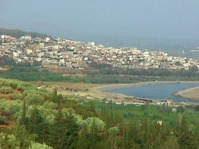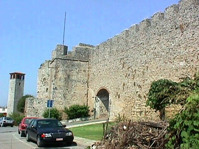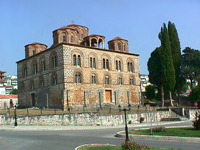Arta
The city of Arta is the capital city of the homonymous prefecture. It is at a distance of 360 km. from Athens and 15 km. from Amvrakikos Bay. It has a population of 40.000 habitants. It is built on the ruins of the ancient Amvrakia. The river of Arachthos with its historical bridge surrounds it by its three sides. The seven hills of the city are surrounded by olive groves and orange trees and by a rich mainland.
It has a long history, over 3.000 years. In 625 B.C. the Korinthioi sent away the native Dryopes from Amvrakia and built walls. In 295 B.C. the Macedonians gave it as a gift to the king of Epirus Pyrros, who brought here the capital city of its state. In this period of time the city was full of significant pieces of art and monuments: buildings, status, temples, paintings and many other works of art. The Romans conquered it in 189 B.C. and after that they plundered it and in 31 B.C. they transfered its population to the ancient Nicopolis.
After the destruction of Nicopolis, Arta was rebuilt in the location of today. In 1204 became the capital city of the Despotate of Epirus and was decorated with artistic Byzantine and post-byzantine churches and monasteries by the emperor Michael A’ Doukas Komninagelos.
It became the most important cultural centre of Epirus and was characterised as the “Mistras of northern Greece”. The byzantine castle of Komninoi which was built on the ruins of the walls of Amvrakia, is one of the most beautiful byzantine castles.
In 1449 Arta was given in Turks and was liberated on 24/6/1881. During the Ottoman period its habitants contributed to the fights for freedom. It was distinguished in the literature and army: Maximos Graikos, Nicolaos Skoufas, Georgios Karaiskakis, etc. During the period of Second World War (1941 – ’44) its habitants offered a lot to the greek army. It was the hometown of the general N. Zervas, commander of the national reistance.
In the city they were saved many monuments, ancient and byzantine, from the era of ancient Amvrakia and the Despotate of Epirus. Many founds were discovered by the excavations throughout the years.
In the city of Arta there are many clubs and assocciations: Skoufas Club, Makrygiannis Club and other cultural assocciations.
In Arta it worths visiting:
- The monastery of Parigoritissa
- The historical museum of Skoufas
- The Folk Art Museum of Skoufas
- The offices of Skoufas Club
- The metropolis of Arta
- The building of Zorba
- The castle of Komnimoi
- The archaelogical theatre of Amvrakia
- The churches of St. Theodora, of St. Vasileios
- The historical bridge of the city, etc.







